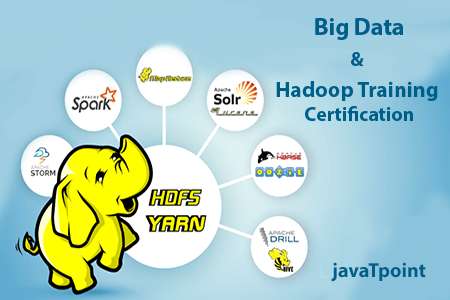Hadoop Tutorial

Hadoop tutorial provides basic and advanced concepts of Hadoop. Our Hadoop tutorial is designed for beginners and professionals.
Hadoop is an open source framework. It is provided by Apache to process and analyze very huge volume of data. It is written in Java and currently used by Google, Facebook, LinkedIn, Yahoo, Twitter etc.
Our Hadoop tutorial includes all topics of Big Data Hadoop with HDFS, MapReduce, Yarn, Hive, HBase, Pig, Sqoop etc.
What is Big Data
Data which are very large in size is called Big Data. Normally we work on data of size MB(WordDoc ,Excel) or maximum GB(Movies, Codes) but data in Peta bytes i.e. 10^15 byte size is called Big Data. It is stated that almost 90% of today's data has been generated in the past 3 years.Sources of Big Data
These data come from many sources like- Social networking sites: Facebook, Google, LinkedIn all these sites generates huge amount of data on a day to day basis as they have billions of users worldwide.
- E-commerce site: Sites like Amazon, Flipkart, Alibaba generates huge amount of logs from which users buying trends can be traced.
- Weather Station: All the weather station and satellite gives very huge data which are stored and manipulated to forecast weather.
- Telecom company: Telecom giants like Airtel, Vodafone study the user trends and accordingly publish their plans and for this they store the data of its million users.
- Share Market: Stock exchange across the world generates huge amount of data through its daily transaction.
3V's of Big Data
- Velocity: The data is increasing at a very fast rate. It is estimated that the volume of data will double in every 2 years.
- Variety: Now a days data are not stored in rows and column. Data is structured as well as unstructured. Log file, CCTV footage is unstructured data. Data which can be saved in tables are structured data like the transaction data of the bank.
- Volume: The amount of data which we deal with is of very large size of Peta bytes.
Use case
An e-commerce site XYZ (having 100 million users) wants to offer a gift voucher of 100$ to its top 10 customers who have spent the most in the previous year.Moreover, they want to find the buying trend of these customers so that company can suggest more items related to them.Issues
Huge amount of unstructured data which needs to be stored, processed and analyzed.Solution
Storage: This huge amount of data, Hadoop uses HDFS (Hadoop Distributed File System) which uses commodity hardware to form clusters and store data in a distributed fashion. It works on Write once, read many times principle.Processing: Map Reduce paradigm is applied to data distributed over network to find the required output.
Analyze: Pig, Hive can be used to analyze the data.
Cost: Hadoop is open source so the cost is no more an issue.
What is Hadoop
Hadoop is an open source framework from Apache and is used to store process and analyze data which are very huge in volume. Hadoop is written in Java and is not OLAP (online analytical processing). It is used for batch/offline processing.It is being used by Facebook, Yahoo, Google, Twitter, LinkedIn and many more. Moreover it can be scaled up just by adding nodes in the cluster.Modules of Hadoop
- HDFS: Hadoop Distributed File System. Google published its paper GFS and on the basis of that HDFS was developed. It states that the files will be broken into blocks and stored in nodes over the distributed architecture.
- Yarn: Yet another Resource Negotiator is used for job scheduling and manage the cluster.
- Map Reduce: This is a framework which helps Java programs to do the parallel computation on data using key value pair. The Map task takes input data and converts it into a data set which can be computed in Key value pair. The output of Map task is consumed by reduce task and then the out of reducer gives the desired result.
- Hadoop Common: These Java libraries are used to start Hadoop and are used by other Hadoop modules.
Advantages of Hadoop
- Fast: In HDFS the data distributed over the cluster and are mapped which helps in faster retrieval. Even the tools to process the data are often on the same servers, thus reducing the processing time. It is able to process terabytes of data in minutes and Peta bytes in hours.
- Scalable: Hadoop cluster can be extended by just adding nodes in the cluster.
- Cost Effective: Hadoop is open source and uses commodity hardware to store data so it really cost effective as compared to traditional relational database management system.
- Resilient to failure: HDFS has the property with which it can replicate data over the network, so if one node is down or some other network failure happens, then Hadoop takes the other copy of data and use it. Normally, data are replicated thrice but the replication factor is configurable.
No comments:
Post a Comment